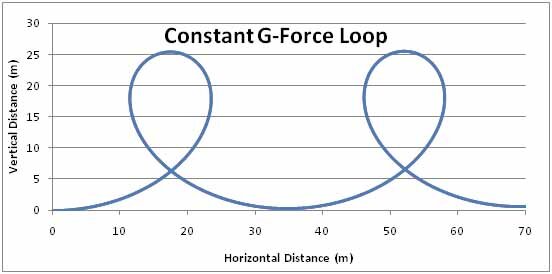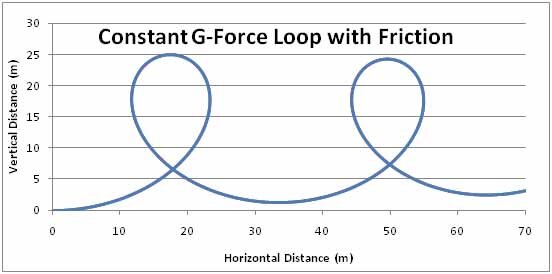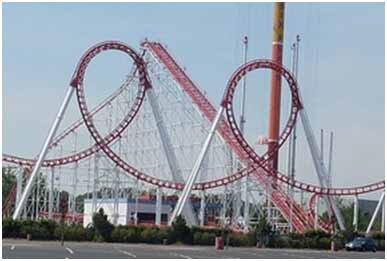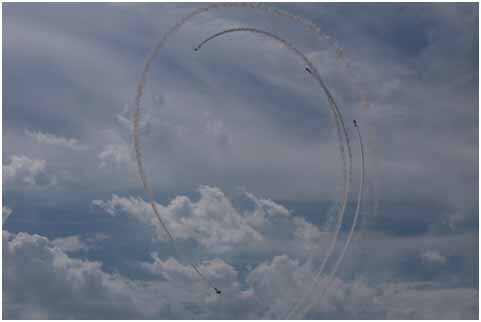Last month's challenge was define the shape of a roller coaster loop that would create a constant G-force experience. We asked what shape to start with, and how to modify it to make the loop.
To create a constant G-force loop, you can start with the basic shape of a circle. Traveling around a circle creates a centripetal force that the rider experiences as a G-force. The force is a function of speed and radius, but, just like gravity, is proportional to the rider’s body mass. So, like gravity, the centripetal force can be expressed as acceleration and applied to any sized person. The centripetal acceleration around a circle is expressed as:
Eq 1. a = V2/r
where A is the acceleration, V is the velocity, and r is the radius.
However, if an entire loop were a circle with constant radius, there would be two big problems:
1. The roller coaster slows down as it climbs the loop, so centripetal acceleration would drop near the top.
2. Gravitational acceleration and centripetal acceleration are additive at the bottom of the loop, where they both push the rider into the bottom of the seat, but opposite at the top of the loop, where centripetal acceleration pushes the rider into the seat, but gravity tries to pull him out.
So to account for problem 1 and maintain constant acceleration, we must take our circular loop and bend it so that it has a smaller radius as the height increases.
To account for problem 2, we must also vary the radius, but this time as a function of the angle of travel instead of the height. The amount that gravity pushes the rider into the seat is the gravitational constant multiplied by the cosine of the angle the rider is traveling. Thus when the rider is traveling horizontally at the bottom of the loop, gravity gives him a 1G load. Travelling horizontally at the top of the loop, gravity gives a negative 1G component. While travel vertically either up or down the sides or the loop, the gravitation component is zero. So to counteract the variable effects of gravity based on angle by adding or subtracting an equivalent amount of centripetal acceleration, we must further decrease the radius at the top and increase it at the bottom of the loop.
The result of these two considerations is an equation for the radius of the curve based on the starting velocity, height, and angle of the track around the curve. That equation is:
Eq2. R = (V0² - 2*G*h) / (a -G*cos(theta))
This can be turned into a differential equation and solved numerically, and is easily done with a number of tools including Matlab or LabView. For greater accessibility, I performed a simple Euler integration in Excel. The spreadsheet is available for the curious here.
So staring with an initial condition equal to the maximum speed of our favorite (and now defunct) rollercoaster, the Six Flags Great America Shockwave, and calculating for a 3.5G loop pair, the outcome is the following curve:

This loop pair assumes that the roller coaster speed in only a function of height. This assumption is probably good enough for one loop, but of a string of loops, it would be better to put in a friction component and have the coaster slow down as it goes through the loops. In this case, for constant acceleration, each loop is smaller than the previous one.

And that’s just what we see in this photo of loops 2 and 3 of the (also now defunct) Great American Scream Machine at Six Flags Great Adventure, sister coaster to the Shockwave. (The only to remain operational of the three nearly identical coasters is the Viper at Six Flags Magic Mountain in California.)

The Cycloid loop
There is a shape in mathematics which looks a whole lot like our constant G-force loop; it is called the Prolate Cycloid. A Cycloid is the shape in X-Y space traced by a point on the edge of circle rolling on a straight line. A Prolate Cycloid is the shape in X-Y space traced by a point fixed to a circle, but outside the circle while the circle rolls along a straight line. When flipped upside down, this shape looks almost exactly like our rollercoaster loop. The shapes are so similar that when properly overlaid, it is hard to see the difference.

A cycloid can be a constant G-force curve, but not under rollercoaster conditions. A person sitting on the edge of a rolling circle feels the same thing a person sitting on a fixed center spinning wheel would – constant centripetal force. However, that condition doesn’t perfectly mimic the height-based velocity decrease we experience with the rollercoaster. I have calculated that, in this case, the prolate cycloid loop rider would experience about a 15% drop in G-force at the point where the loop is vertical compared to the constant G loop. So this solution comes up just short of our goal. There is a sheet in the Excel file dedicated to this comparison.
Clothoids
A Clothoid is a type of spiral where the radius changes uniformly over distance. It is commonly used as a transition curve for roads and railroads. A rollercoaster loop can be built using two clothoids closely approximating the constant acceleration curve, much like the cycloid loop. Additionally, more than two can be used to even more closely approximate the ideal solution.
Other Examples of Constant G-Force Loops
The same constant G-force loop can also be flown by a pilot in an air show. If the drag of the wing of the tightly looping aircraft exactly equals the thrust from the propeller, the equations from our rollercoaster loop would apply to the airplane. This is illustrated in Leon Grossman’s photo from this year’s Chicago Air and Water show.

Assumptions and Simplifications
1. Ignoring rotational inertia: All of the discussion in this article and the article published by the University of Gothenburg, Sweden treats the rollercoaster train as a point mass. In reality, it has rotational inertia which would further decrease the forward velocity during the smallest radius portions of the loop. I believe this effect to be negligible.
2. Ignoring train length: The models used here treat the train as having only one height at a given time. In reality, the train is pretty long compared to the loop, and the front nears the top while the back car may be half way up the loop. Since all cars are connected, they all have the same velocity at any given time. So a rider in the lead car will experience a higher than normal G-load at the top of the loop, while a rider in the back car will experience a decrease in G-load up the side of the loop, followed by the high G-load at the top as the rest of the train accelerates down the back side of the loop. This disparity of experience dependant on position is one of the great things about rollercoasters.
3. Really basic friction modeling: An actual rollercoaster designer would develop a much more complicated friction model than has been done here. Friction sources to account for include wind resistance which is a function primarily of velocity, and rolling friction which will be a function of both speed and G-load.
Learn more about DMC's company culture.